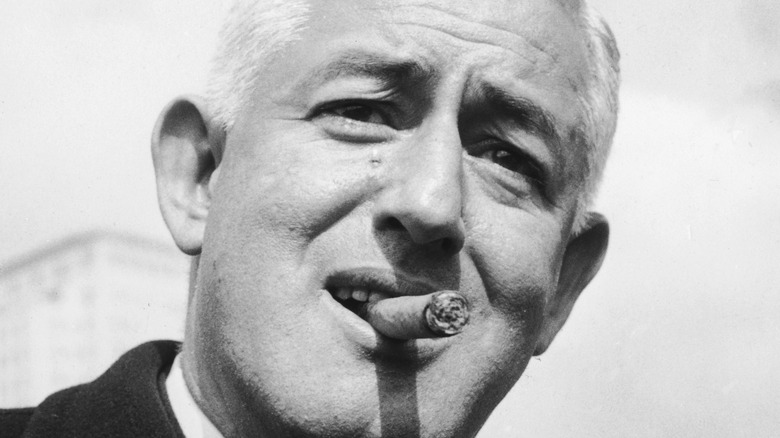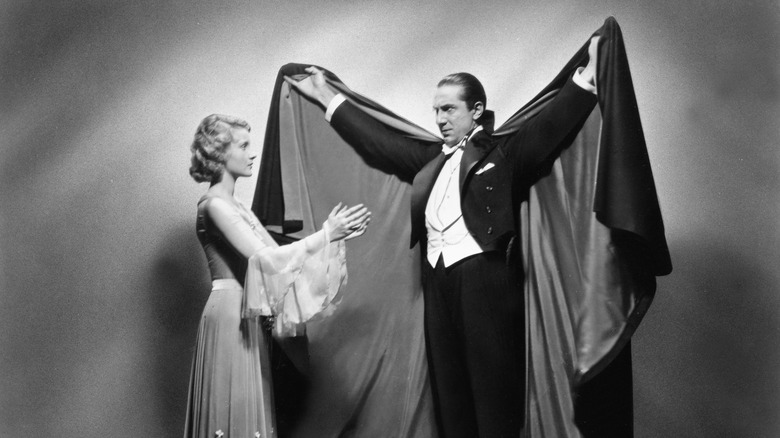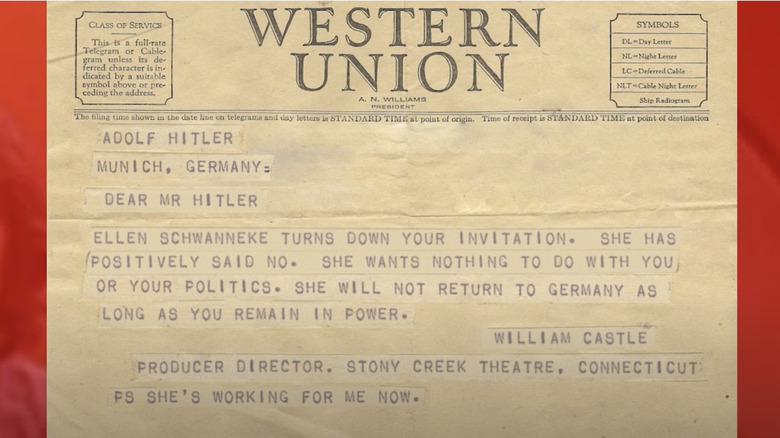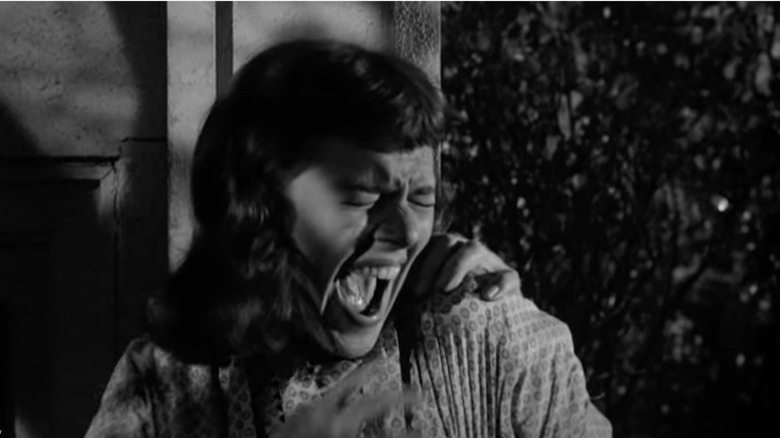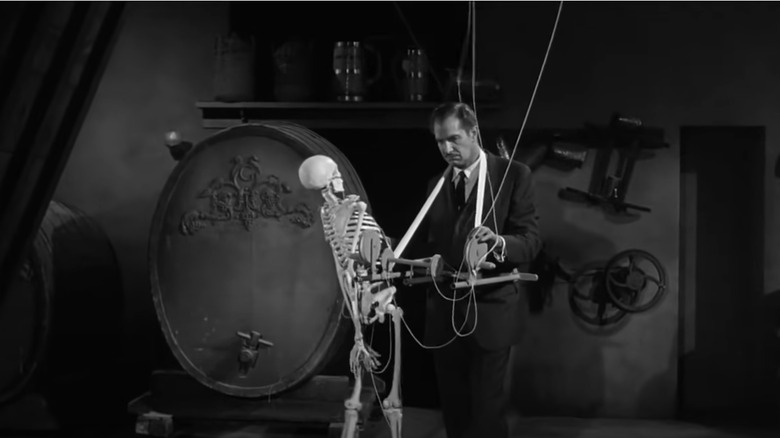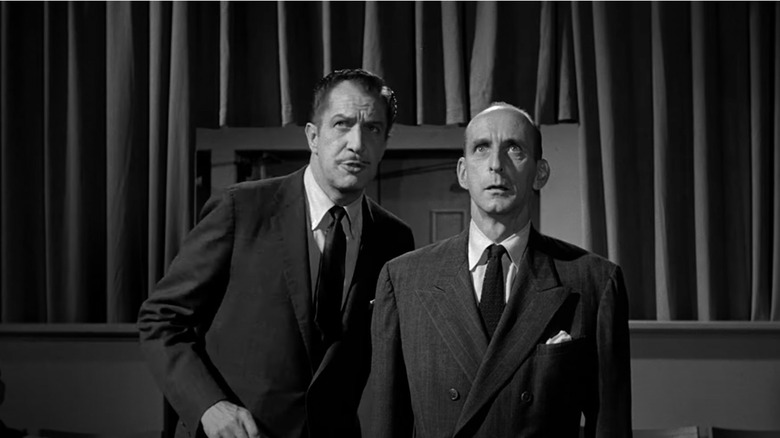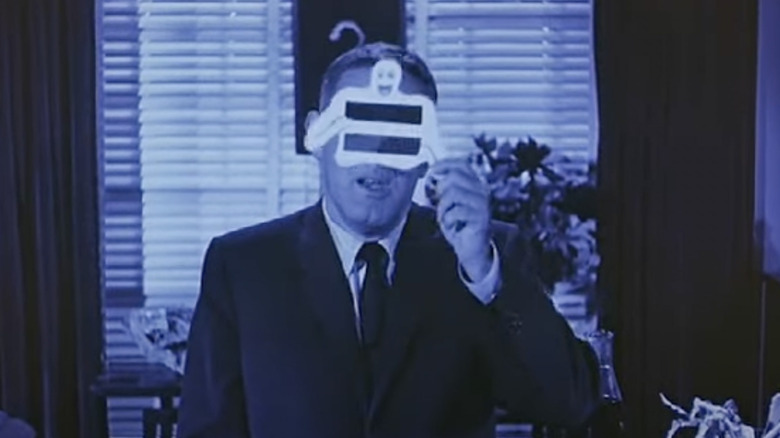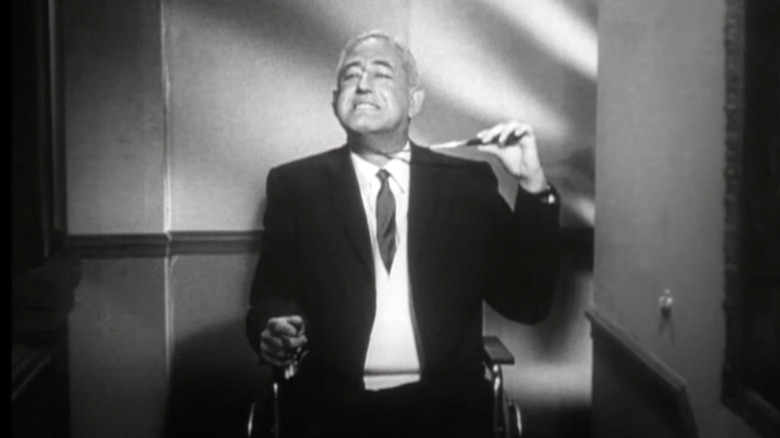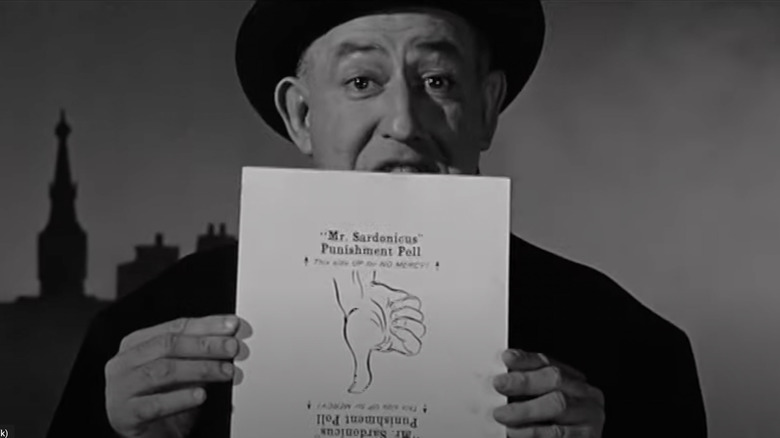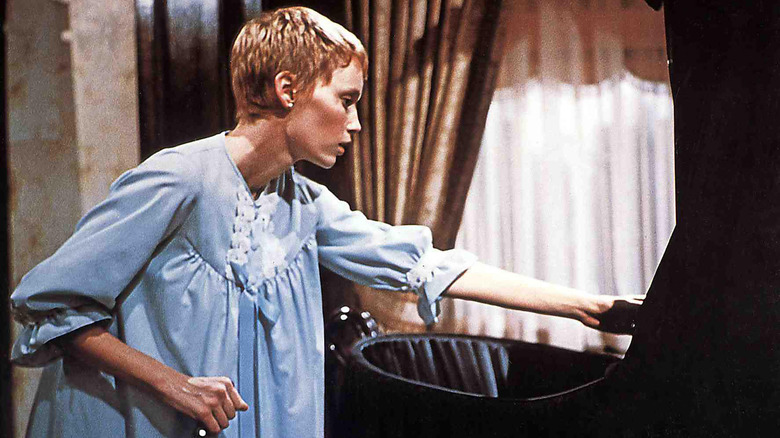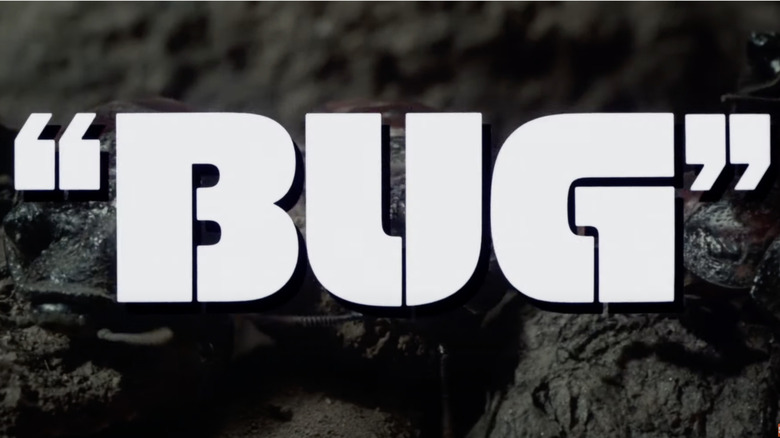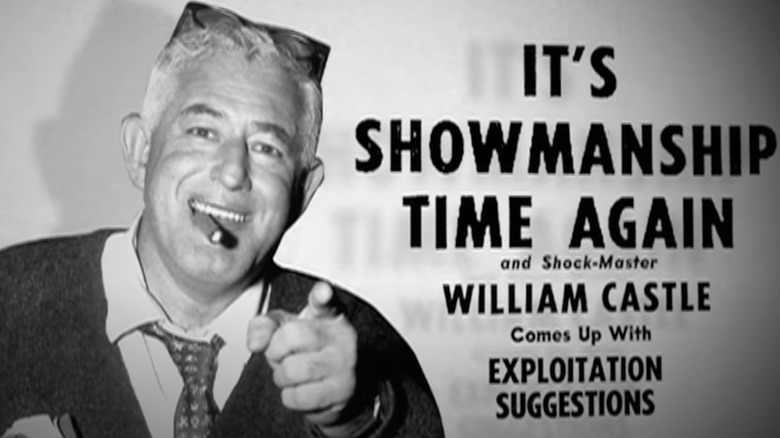William Castle: The P.T. Barnum Of Horror Films
You might not recognize the name William Castle, but you most likely recognize his style. As one of the best-known directors of mid-20th-century B-horror movies (along with now-beloved Ed Wood), Castle crafted worlds on film that were simultaneously spooky and unsettling and campy and tongue-in-cheek, providing the perfect canvas for madness and mayhem. With titles such as "Macabre," "The Tingler," and "Homicidal," Castle aimed to chill America's spines and keep on going, right over the top.
Born William Schloss on April 24, 1914, in New York City, he translated his family's German last name into its Anglo counterpart, "Castle" when getting into show biz, via directing an off-Broadway production of Bram Stoker's "Dracula," according to Encyclopedia Brittanica.
Per the New York Times, in an interview from 1960, Castle said, "I've modeled my career on (P.T.) Barnum ... Gimmicks, surprise, shock — that's what draws the crowds." It was a comparison that would follow him around in the press through the present day. So what was so circus-like about Castle's work? In a word: gimmicks. With each movie, there came an outrageous accompanying gimmick, one meant to enmesh the audience to the action on the screen. There were life insurance policies, buzzers, and public humiliation, and people flocked to be a part of the spectacle.
Bela Lugosi's Dracula made Castle realize his calling
As is often the case with successful people in show business, William Castle didn't have the easiest start in life. As Castle himself wrote in his autobiography, "Step Right Up! ... I'm Gonna Scare the Pants Off America," (via Films of the Golden Age) he was never much of a student, and was teased as a child because of his German name and physical awkwardness. To make matters worse, his mother died of pneumonia when he was just 10 years old, and his father died just a year later of a heart attack. When he went to live with his older sister and her husband, his pain and grief drove him to the brink of self-destruction, once even compelling him to jump into the Hudson River.
But in 1927, the 13-year old found himself at the Broadway production of "Dracula" starring none other than Bela Lugosi, and his life changed forever. Castle was so spellbound by the production and its blood-sucking star that he would see the show multiple times. Per Little White Lies, Castle wrote: "I knew then what I wanted to do with my life... I wanted to scare the pants off audiences." He would eventually meet Lugosi, who took the boy under his batwing, and got him an assistant stage manager job in the play's touring production. That job would morph into several others, and lead to Castle somehow obtaining Orson Welles' phone number and leasing a theater from him...
The first gimmick: Not for Children and fake vandalism
At 25 years old, William Castle worked his many connections in the theater world to make contact with star Orson Welles. According to Films of the Golden Age, he persuaded Welles to let him stage his own production in Welles' personal pre-Broadway testing theater in Connecticut.
Castle cast German actress Ellen Schwanneke, who had fled Germany to escape the Nazis,to perform in one of his plays. But, per Little White Lies, The Actors Equity Association contacted Castle to let him know he couldn't hire Schwanneke because American actors had priority unless the project was tailored for a foreign performer. Castle pivoted by falsely claiming he'd written a play called "Das ist nicht für Kinder" ("Not For Children"). He then allegedly wrote the play in a weekend and had it translated into German. Meanwhile, Adolf Hitler sent Schwanneke an invitation to an event in Munich, which Castle responded to via telegram: "She will not return to Germany as long as you remain in power ... P.S. She's working for me now." He then sent copies to major newspapers.
"ReFocus: The Films of William Castle" discussed subsequent controversy. Some angry pro-Nazi vandals allegedly smashed up the theater and spraypainted swastikas on the walls the night before the play opened, causing Castle to demand armed protection from the National Guard for the opening. Castle later admitted that he'd done the vandalism himself for the dramatic publicity.
Macabre and the life insurance policy
In 1958, the William Castle-directed "Macabre" attempted to scare the pants off theaters everywhere. Per Turner Classic Movies, this twisting and turning tale tells the story of a small-town doctor and widower whose 3-year-old daughter has been kidnapped, trapped in a coffin, and only has a few hours to live. As the doctor and his faithful nurse frantically try to figure out where the child is, dark and sordid secrets and shady love triangles unfurl until the mystery is solved and (spoiler alert) the child is found safe. Unfortunately, "safe" was not the fate of several of the rest of the movie's key players.
Smithsonian Magazine reported that as a tie-in to a convoluted insurance scam and death-by-fright that figure into the action, Castle took out splashy ads in major magazines advertising that the film's producers would pay $1,000 to the benefactors of anyone who died of fright while viewing "Macabre." And this gimmick was actually true; movie-goers had to sign very real life insurance policies from Lloyd's of London before they could enter theaters. Castle himself appeared at many major-city premieres, arriving in a hearse or even a coffin. Sadly for the press-loving Castle, though, no audience members perished and collected.
House on Haunted Hill and Emergo
William Castle's next film, "House on Haunted Hill," was one of his most successful thanks in no small part to its ethereal, luminous star, Vincent Price. Per Turner Classic Movies, Price plays former playboy Frederick Loren, who rents a reputedly-haunted mansion for a party for his wife, Annabelle. He invites five people, promising them $10,000 each if they can spend the entire night at the mansion. One of the guests is the owner of the mansion, who, after another guest's near-miss with a chandelier, explains that there were 7 murders in the house, and he believes the victims' ghosts haunted the place. Many screams, suspicious glances, and wild accusations ensue.
Haunted house movies often chose classic Victorians for their settings, but interestingly, Castle chose a Frank Lloyd Wright design for his exterior. According to Architect Magazine, Ennis House in Los Feliz, California, was a shining example of Mayan Revival architecture. The house's more modern structure made the horrors within that much more unsettling. But that was not the movie's gimmick.
"House on Haunted Hill" boasted "Emergo," which was a fake skeleton rigged up in movie theaters that would fly over audiences' heads at a key, tense moment. In an article posted on Turner Classic Movies, Price recalled being at showing with an audience of young people when Emergo emerged: "[They] panicked! ... They just took down the first five rows. I loved it!"
The Tingler and Percepto
"The Tingler" followed in 1959, and it offered a much more immersive horror experience for audiences. Again featuring Vincent Price, this time as Dr. Warren Chapin, a pathologist studying the effects of fear on the human body, "The Tingler" explores Chapin's search for what exactly causes that tingle in your spine when you're scared. According to IMDb, through a set of bizarre scenarios and coincidences, Chapin discovers that what he'd thought was just a sensation was in fact a physical creature dwelling in every human's spine; it resembled a black lobster that would kill its host unless it's destroyed by screaming, which dissipated fear. Chapin manages to capture one of these Tinglers for research, but it eventually escapes. Into the very theater in which you are sitting!
This is where the brilliant "Percepto" gimmick kicks in. In a gleeful video on YouTube, actor Darryll Hickman (who played Chapin's pathology assistant) and others involved in the movie discuss what happened next. Chapin breaks the fourth wall as he explains that the Tingler is loose in the theater, and that if someone felt a tingling in their spine (triggered by buzzers installed in every few seats), to "Scream! Scream for Your Lives!" Hired extras in certain theaters escalated the terror, and eventually the creature is re-captured.
13 Ghosts and Illusion-O
In 1960, "13 Ghosts" rounded out William Castle's trilogy of most-successful movies with another fabulous gimmick, "Illusion-O." The movie follows a down-on-their-luck family barely able to make ends meet, viper Turner Classic Movies. They inherit the estate of the father's late uncle, who apparently collected ghosts — 13, to be exact — and move in because their finances make it an offer they can't refuse. The estate also comes with a creepy housekeeper, called "the witch" by the family's attorney, and played by Margaret Hamilton, who played the Wicked Witch of the West in "The Wizard of Oz." The family then has to navigate the hauntings and staying in their new home.
Per an article at Movies!, audiences attending "13 Ghosts" were given cardboard "ghost-viewers," shaped like a classic ghost, and dubbed "Illusion-O." They were essentially 3D glasses which oriented one lens over the other instead of side-by-side. When the words "Use Viewer" came on the screen, patrons could look through a red lens to see ghosts or a blue lens to not see ghosts in key scenes, depending on their personal fear tolerance.
Homicidal and the Fright Break
In 1961, William Castle directed "Homicidal," another disturbing ode to humanity's dark side. IMDb describes a plot wherein a woman named Miriam and her brother Warren are reunited as adults as he is about to turn 21 and receive their father's inheritance money. Their reunion, which includes their childhood nanny, is a happy one, except for the weird, moody, mysterious woman named Emily who has returned with Warren and the nanny. Emily's increasingly erratic, aggressive behavior sets everyone on edge, escalating the tension toward the movie's violent, upsetting conclusion.
Castle himself came on the screen and offered a "Fright Break" a couple minutes before the ending, promising a full refund to any audience member who couldn't bring themselves to stay till the end. One of Castle's biggest and most famous fans, John Waters, wrote in his book, "Crackpot" that one of the first times the Fright Break was tested on an audience, everyone ran to the box office for their refunds. But Castle figured out that this audience had already seen the entire film, so knew the ending, but wanted the refund for the second viewing. Castle then issued different colored tickets for each showing, and refund demand plummeted. But those who did opt out had to follow yellow footsteps to the lobby as Castle's voice berated them, and they would then have to sign a paper saying "I am a bona fide coward" at a box labeled "Coward's Corner" before their money was refunded.
Mr. Sardonicus and the Punishment Poll
Also in 1961, William Castle released "Mr. Sardonicus," a Gothic tale set in 19th-century Europe, based on a short story called "Sardonicus" by Ray Russell that had been published in "Playboy." Turner Classic Movies explains that it's the story of a medical pioneer who specialized in curing nervous disorders with certain toxins. He's summoned by a former love to help her current husband, a baron whose face had hideously contorted from fear years earlier when he'd dug up his father's grave to steal a lottery ticket. The baron had been experimenting with leeches and young maidens' faces in the hopes of finding a cure, but had been unsuccessful. When things take a turn and the female romantic lead is threatened with facial disfigurement, the physician saves her, and leaves the baron to a cruel fate ... Or does he? It all depended on the audience, supposedly.
Castle said that Columbia didn't like the downbeat ending, and requested a more upbeat one. His solution was to let the audience decide, so movie-goers were given cards with thumbs-up to vote for mercy, and thumbs-down for no mercy. Sardonicus' cruelty had been so outrageous, that audiences rarely (if ever) voted for mercy, and while Castle asserted he had filmed an alternate, feel-good ending, none has ever surfaced.
Rosemary's Baby
In 1968 came William Castle's biggest commercial success, "Rosemary's Baby," starring Mia Farrow: a tale of a young married couple who wants to have a baby, moves into a new apartment building, and ends up with the literal spawn of Satan (per IMDb). The story focused on Catholicism and its dark side, Satanism.
According to an article at Turner Classic Movies, Castle bought the rights to the novel, written by Ira Levin, before it was even out of its galley phase, thanks to a literary agent pal. Castle's plan was to direct and produce per usual, but since he'd spent all his money on securing the rights to the novel, he had to jump to a different studio who, famously, insisted Roman Polanski direct the film. Castle agreed to produce, and leave the directing to Polanski, but he wasn't happy about it.
Castle wrote about a particularly painful case of gallstones in his "Step Right Up!" autobiography (via TCM), along with several other unlucky happenings to the movie's cast and crew. "The story of Rosemary's Baby was happening in real life," he wrote. "Witches, all of them, were casting their spell, and I was becoming one of the principal players."
BUG
In 1975, William Castle produced "BUG," the timeless story of mutant cockroaches unleashed on a small town by a major earthquake. IMDb explains that these cockroaches are a little extra – they can start fires by rubbing their little cerci appendages together, and then set flame to anything or anyone they care to, including the wife of the main scientist, who vows revenge. The roaches get their nutrition from the burnt, carbon parts of their victims.
The movie was classic Castle fare, but once again, he didn't direct it. Instead, French director Jeannot Szwarc had that honor, with Castle overseeing producer duties. Though Castle's health had been in decline since the stress of "Rosemary's Baby," the master showman had one more gimmick left in him. And that was, according to NewJersey.com, to insure the lead cockroach in "BUG" for a million dollars and take him on a national publicity tour. Hopefully, both received VIP treatment. Sadly, Castle died of a heart attack two years later at the age of 64.
William Castle's Resurrection and 2011 novel
William Castle died in 1977, but the man who scared the pants off America wasn't done with us yet. In 2010, Castle's daughter Terry talked with Dread Central about her father's alleged then-recent activity on social media, as well as a manuscript that would become a novel called "From the Grave: The Prayer" the following year. "All I know is what you know and that is that William Castle is back from the grave," she said. "I know that it's time for a new generation to get to enjoy the same thrills and the same gimmicks; some hi-tech, some low-tech."
There's not much solid evidence that Terry Castle (or anyone else for that matter) ghost wrote the novel, but according to Indie Wire, she had written a novel aimed at tweens called "FearMaker: Family Matters," and since some of the characters in her father's novel are similarly aged, and "FearMaker" sounds a lot like something the child of a famous B-horror movie director might write, well, it's all food for thought. Speaking of food, the daughter Castle also shared her father's recipe for the "blood" that oozed all over his movies; water, corn syrup, red and blue food coloring, and chocolate syrup.
You can also read the musings of William Castle's ghost on the blog he wrote in 2010, courtesy of the WayBack Machine. Everyone always knew he was savvy!
The stunt left undone
In a Dread Central interview, Terry Castle discussed her bewilderment at seeing her father's alleged location via social media as Gordes, France. "[He] was buried in Forest Lawn in Glendale, CA and he lived in LA his whole life and he was born in New York, what the hell is he doing in Gordes, France?"
Castle then said she re-read his autobiography and noticed something that made the French location make sense. Her father and mother were on a promotional tour, likely for "House on Haunted Hill," in southern France in 1959, when they spotted a run-down house that looked haunted and therefore, he was quite taken with. "He said, 'I want to buy that house' and my mom said, 'What are you, crazy? Why would you want that house?'" He told his wife he wanted to have millions of keys made to give to everyone who went to see his movies; only one key would be the right one, and whoever ended up with it would be able to spend the weekend. He did buy the house the next day, but never did the key gimmick. How many Castle fans today must wish they had one of those keys, either fake or real!
